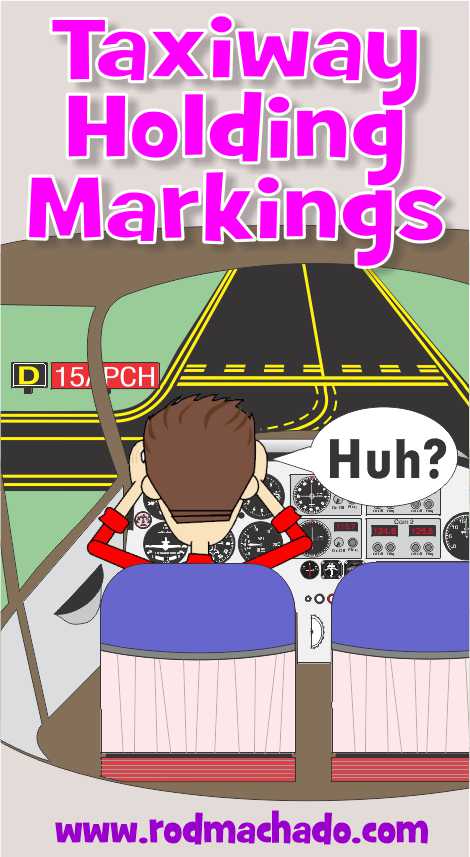By Rod Machado

Here's the scenario: From your present position shown in the graphic above ATC says, "....taxi to Runway 19R via taxiway Whiskey, hold short of Runway 19R at Whiskey Eight." (The beginning of Runway 19R is located at the far, north end of Taxiway W where W8 is also found.)
As you taxi, you come across a set of yellow solid-double and dashed-double hold markings directly ahead of you, as shown in the picture above. What are you required to do?
A. Hold and ask for a clearance to cross the solid double-yellow lines.
B. Nothing. You may cross these lines without an ATC clearance.
C. Cross these lines, then stop. If ATC doesn't say anything, keep going.
If you picked answer A, that would be incorrect. The correct answer is "B."
Wait! Don't go all Hong-Kong Kung-fu on me. Let me explain.
Here's what paragraph 2-3-5(3) of the AIM says.


You can identify these holding position markings on taxiways by the presence of a sign with white-on-red lettering having a runway designation (1L) followed by a dash (-) followed by letters APCH.


Now you know what you are required to do. However, what would you actually do when you encounter holding position markings on a taxiway as shown in the graphics above?
My advice to you is to always stop and query the controller. Period. That's right. STOP and make sure you are cleared to cross those solid double yellow lines! Even if you don't need a clearance to cross the taxiway holding markings, get one anyway, or at least check in with the controller before crossing them. The worst that can happen is that the controller gets uppity with you. If he does, then start speaking to him as fast as he speaks to you. Problem solved.
The fact that there is an exception to the clearance requirement to cross the yellow solid-double and dashed-double lines is note-worthy. Yes, I realize the runway and taxiway hold lines have different names. So what? They look exactly alike, and that's what matters here.
I find it interesting that the FAA goes out of its way to identify likely areas where pilots are might accidentally cross runway hold markings without a clearance. The FAA even give these areas special names called hot spots and depict them on airport taxi diagrams to prevent runway incursions. Then, if a pilot experiences a runway incursion, he's sent to a ground-school-gulag where he's forced to print out runway signs (OK, maybe not, but it feels like that, anyway). My point is, everyone knows that runway incursions are serious events! The FAA's exception to the clearance requirement for crossing holding markings on a taxiway seems likely to increase these incursions, not lessen them. It's a deeply unwise policy, in my opinion.
What's my solution to the FAA's policy here? Why not require a clearance to cross all taxiway holding markings? If I were in charge of the FAA for a day (the longest I would remain in the job before being fired and sent to that gulag I mentioned earlier), I would require a clearance to cross "ALL" taxiway holding markings. That seems like common sense to me.
It's been said before and it's appropriate to say it again (with a twist). You can fool some pilots some of the time, but you can't fool all pilots all the time--however, taxiway holding markings come pretty close.

